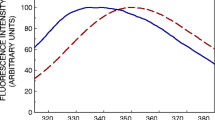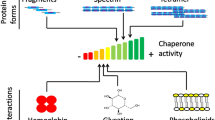Abstract
Spectrin is a rod-like multi-modular protein that is mainly composed of triple-helical repeats. These repeats show very similar 3D-structures but variable conformational and thermodynamical stabilities, which may be of great importance for the flexibility and dynamic behaviour of spectrin in the cell. For instance, repeat 17 (R17) of the chicken brain spectrin α-chain is four times less stable than neighbouring repeat 16 (R16) in terms of ∆G. The structure of spectrin repeats has mainly been investigated by X-ray crystallography, but the structures of a few repeats, e.g. R16, have also been determined by NMR spectroscopy. Here, we undertook a detailed characterization of the neighbouring R17 by NMR spectroscopy. We assigned most backbone resonances and observed NOE restraints, relaxation values and coupling constants that all indicated that the fold of R17 is highly similar to that of R16, in agreement with previous X-ray analysis of a tandem repeat of the two domains. However, 15N heteronuclear NMR spectra measured at different temperatures revealed particular features of the R17 domain that might contribute to its lower stability. Conformational exchange appeared to alter the linker connecting R17 to R16 as well as the BC-loop in close proximity. In addition, heat-induced splitting was observed for backbone resonances of a few spatially related residues including V99 of helix C, which in R16 is replaced by the larger hydrophobic tryptophan residue that is relatively conserved among other spectrin repeats. These data support the view that the substitution of tryptophan by valine at this position may contribute to the lower stability of R17.






Similar content being viewed by others
Notes
Amino acid numbering in parentheses is according to the nomenclature of Yan et al. (1993).
References
An XL, Zhang XH, Salomao M, Guo XH, Yang Y, Wu Y, Gratzer W, Baines AJ, Mohandas N (2006) Thermal stabilities of brain spectrin and the constituent repeats of subunits. Biochemistry 45(45):13670–13676. doi:10.1021/bi061368x
Batey S, Scott KA, Clarke J (2006) Complex folding kinetics of a multidomain protein. Biophys J 90(6):2120–2130. doi:10.1529/biophysj.105.072710
Bennett V, Gilligan DM (1993) The spectrin-based membrane skeleton and micron-scala organization of the plasma-membrane. Annu Rev Cell Biol 9:27–66
Carugo KD, Banuelos S, Saraste M (1997) Crystal structure of a calponin homology domain. Nat Struct Biol 4(3):175–179
Davis AL, Keeler J, Laue ED, Moskau D (1992) Experiments for recording pure-absorption heteronuclear correlation spectra using pulsed field gradients. J Magn Reson 98(1):207–216
de la Torre JG, Huertas ML, Carrasco B (2000) HYDRONMR: prediction of NMR relaxation of globular proteins from atomic-level structures and hydrodynamic calculations. J Magn Reson 147(1):138–146. doi:10.1006/jmre.2000.2170
Delaglio F, Grzesiek S, Vuister GW, Zhu G, Pfeifer J, Bax A (1995) NMRPipe—a multidimensional spectral processing system based on UNIX Pipes. J Biomol NMR 6(3):277–293
Diercks T, Coles M, Kessler H (1999) An efficient strategy for assignment of cross-peaks in 3D heteronuclear NOESY experiments. J Biomol NMR 15(2):177–180
Dosset P, Hus JC, Blackledge M, Marion D (2000) Efficient analysis of macromolecular rotational diffusion from heteronuclear relaxation data. J Biomol NMR 16(1):23–28
Edgar RC (2004) MUSCLE: multiple sequence alignment with high accuracy and high throughput. Nucleic Acids Res 32(5):1792–1797. doi:10.1093/nar/gkh340
Fung LWM, Lu HZ, Hjelm RP, Johnson ME (1986) Selective detection of rapid motions in spectrin by NMR. FEBS Lett 197(1–2):234–238
Fung LWM, Lu HZ, Hjelm RP, Johnson ME (1989) Quantitative detection of rapid motions in spectrin by NMR. Life Sci 44(11):735–740
Grum VL, Li DN, MacDonald RI, Mondragon A (1999) Structures of two repeats of spectrin suggest models of flexibility. Cell 98(4):523–535
Grzesiek S, Bax A (1993a) Amino-acid type determination in the sequential assignment procedure of uniformly C-13/N-15-enriched proteins. J Biomol NMR 3(2):185–204
Grzesiek S, Bax A (1993b) The importance of not saturating H2O in protein NMR—application to sensitivity enhancement and NOE measurements. J Amer Chem Soc 115(26):12593–12594
Grzesiek S, Anglister J, Bax A (1993) Correlation of backbone amide and aliphatic side-chain resonances in C-13/N-15-enriched proteins by isotropic mixing of C-13 magnetization. J Magn Reson B 101(1):114–119
Harris RK, Becker ED, De Menezes SMC, Granger P, Hoffman RE, Zilm KW (2008) Further conventions for NMR shielding and chemical shifts (IUPAC recommendations 2008). Pure Appl Chem 80(1):59–84. doi:10.1351/pac200880010059
Kamath U, Shriver JW (1989) Characteriazation of thermotropic state changes in myosin subfragment-1 and heavy-meromyosin by UV difference spectroscopy. J Biol Chem 264(10):5586–5592
Kay LE, Torchia DA, Bax A (1989) Backbone dynamics of proteins as studied by N-15 inverse detected heteronuclear NMR-spectroscopy—application to staphylococcal nuclease. Biochemistry 28(23):8972–8979
Keller RLJ (2005) Optimizing the process of nuclear magnetic resonance spectrum analysis and computer aided resonance assignment. ETH Zürich, Zürich
Kowalski K, Merkel AL, Booker GW (2004) H-1, C-13 and N-15 resonance assignments of the third spectrin repeat of alpha-actinin-4. J Biomol NMR 29(4):533–534. doi:10.1023/b:jnmr.0000034342.20537.01
Kusunoki H, Macdonald RI, Mondragon A (2004a) Structural insights into the stability and flexibility of unusual erythroid spectrin repeats. Structure 12(4):645–656. doi:10.1016/j.str.2004.02.022
Kusunoki H, Minasov G, MacDonald RI, Mondragon A (2004b) Independent movement, dimerization and stability of tandem repeats of chicken brain alpha-spectrin. J Mol Biol 344(2):495–511. doi:10.1016/j.jmb.2004.09.019
Legardinier S, Legrand B, Raguenes-Nicol C, Bondon A, Hardy S, Tascon C, Le Rumeur E, Hubert JF (2009) A two-amino acid mutation encountered in Duchenne muscular dystrophy decreases stability of the rod domain 23 (R23) spectrin-like repeat of dystrophin. J Biol Chem 284(13):8813–8823. doi:10.1074/jbc.M805846200
Lipari G, Szabo A (1982a) Model-free approach to the interpretation of nuclear magnetic-resonance relaxation in macromolecules. 1. Theory and range of validity. J Am Chem Soc 104(17):4546–4559
Lipari G, Szabo A (1982b) Model-free approach to the interpretation of nuclear magnetic-resonance relaxation in macromolecules. 2. Analysis of experimental results. J Am Chem Soc 104(17):4559–4570
MacDonald RI, Musacchio A, Holmgren RA, Saraste M (1994) Invariant tryptophan at a shielded site promotes folding of the conformational unit of spectrin. Proc Natl Acad Sci 91(4):1299–1303
Montelione GT, Lyons BA, Emerson SD, Tashiro M (1992) An efficient triple resonance experiments using C-13 isotropic mixing for determining sequence-specific resonance assignments of isotopically-enriched proteins. J Am Chem Soc 114(27):10974–10975
Musacchio A, Noble M, Pauptit R, Wierenga R, Saraste M (1992) Crystal-structure of a src-homology-3 (SH3) domain. Nature 359(6398):851–855
Pantazatos DP, MacDonald RI (1997) Site-directed mutagenesis of either the highly conserved Trp-22 or the moderately conserved Trp-95 to a large, hydrophobic residue reduces the thermodynamic stability of a spectrin repeating unit. J Biol Chem 272(34):21052–21059
Park S, Caffrey MS, Johnson ME, Fung LWM (2003) Solution structural studies on human erythrocyte alpha-spectrin tetramerization site. J Biol Chem 278(24):21837–21844. doi:10.1074/jbc.M300617200
Parry DAD, Dixon TW, Cohen C (1992) Analysis of the 3-alpha-helix motif in the spectrin superfamily of proteins. Biophys J 61(4):858–867
Pascual J, Pfuhl M, Rivas G, Pastore A, Saraste M (1996) The spectrin repeat folds into a three-helix bundle in solution. FEBS Lett 383(3):201–207
Pascual J, Pfuhl M, Walther D, Saraste M, Nilges M (1997) Solution structure of the spectrin repeat: a left-handed antiparallel triple-helical coiled-coil. J Mol Biol 273:740–751
Sahr KE, Laurila P, Kotula L, Scarpa AL, Coupal E, Leto TL, Linnenbach AJ, Winkelmann JC, Speicher DW, Marchesi VT, Curtis PJ, Forget BG (1990) The complete cDNA and polypeptide sequences of human erythroid alpha-spectrin. J Biol Chem 265(8):4434–4443
Sattler M, Schleucher J, Griesinger C (1999) Heteronuclear multidimensional NMR experiments for the structure determination of proteins in solution employing pulsed field gradients. Prog Nucl Magn Reson Spectrosc 34(2):93–158
Schanda P, Kupce E, Brutscher B (2005) SOFAST-HMQC experiments for recording two-dimensional heteronuclear correlation spectra of proteins within a few seconds. J Biomol NMR 33(4):199–211. doi:10.1007/s10858-005-4425-x
Schubert M, Smalla M, Schmieder P, Oschkinat H (1999) MUSIC in triple-resonance experiments: amino acid type-selective H-1-N-15 correlations. J Magn Reson 141(1):34–43
Schubert M, Oschkinat H, Schmieder P (2001a) MUSIC and aromatic residues: Amino acid type-selective H-1-N-15 correlations, III. J Magn Reson 153(2):186–192. doi:10.1006/jmre.2001.2447
Schubert M, Oschkinat H, Schmieder P (2001b) MUSIC, selective pulses, and tuned delays: Amino acid type-selective H-1-N-15 correlations, II. J Magn Reson 148(1):61–72
Travé G, Lacombe PJ, Pfuhl M, Saraste M, Pastore A (1995) Molecular mechanism of the calcium-induced conformational change in the spectrin EF-hands. EMBO J 14(20):4922–4931
Vranken WF, Boucher W, Stevens TJ, Fogh RH, Pajon A, Llinas P, Ulrich EL, Markley JL, Ionides J, Laue ED (2005) The CCPN data model for NMR spectroscopy: development of a software pipeline. Proteins Struct Funct Bioinform 59(4):687–696. doi:10.1002/prot.20449
Vuister GW, Bax A (1993) Quantitative J correlation—a new approach for measuring homonuclear 3-bond J(H(N)H(alpha)) coupling-constants in N-15-enriched proteins. J Am Chem Soc 115(17):7772–7777
Wang YJ, Jardetzky O (2002) Probability-based protein secondary structure identification using combined NMR chemical-shift data. Protein Sci 11(4):852–861. doi:10.1110/ps.3180102
Waterhouse AM, Procter JB, Martin DMA, Clamp M, Barton GJ (2009) Jalview Version 2-a multiple sequence alignment editor and analysis workbench. Bioinformatics 25(9):1189–1191. doi:10.1093/bioinformatics/btp033
Weisemann R, Ruterjans H, Schwalbe H, Schleucher J, Bermel W, Griesinger C (1994) Determination of H(N), H-alpha and H(N), C′ coupling-constants in C-13, N-15-labeled proteins. J Biomol NMR 4(2):231–240
Winkelmann JC, Costa FF, Linzie BL, Forget BG (1990) Beta-spectrin in human skeletal-muscle–tissue-specific differential processing of 3′ beta-spectrin pre-messenger-RNA generates a beta-spectrin isoform with a unique carboxyl terminus. J Biol Chem 265(33):20449–20454
Wishart DS, Sykes BD, Richards FM (1991) Relationship between nuclear-magnetic-resonance chemical-shift and protein secondary structure. J Mol Biol 222(2):311–333
Wishart DS, Bigam CG, Yao J, Abildgaard F, Dyson HJ, Oldfield E, Markley JL, Sykes BD (1995) H-1, C-13 and N-15 chemical-shift referencing in biomolecular NMR. J Biomol NMR 6(2):135–140
Wüthrich K, Billeter M, Braun W (1984) Polypeptide secondary structure determination by nuclear magnetic-resonance observation of short proton proton distances. J Mol Biol 180(3):715–740
Yamazaki T, Formankay JD, Kay LE (1993) 2-Dimensional NMR experiments for correlating C-13-beta and H-1-delta/epsilon chemical-shifts of aromatic residues in C-13-labeled proteins via scalar couplings. J Am Chem Soc 115(23):11054–11055
Yan Y, Winograd E, Viel A, Cronin T, Harrison SC, Branton D (1993) Crystal-structure of the repetetive segments of spectrin. Science 262:2027–2030
Acknowledgments
We are grateful to Anne Chapelle for preparation of isotopically labelled samples of the R17 domain, and to Jarl Underhaug for help with the NMRPipe-scripts for the relaxation study.
Author information
Authors and Affiliations
Corresponding author
Electronic supplementary material
Below is the link to the electronic supplementary material.
Rights and permissions
About this article
Cite this article
Brenner, A.K., Kieffer, B., Travé, G. et al. Thermal stability of chicken brain α-spectrin repeat 17: a spectroscopic study. J Biomol NMR 53, 71–83 (2012). https://doi.org/10.1007/s10858-012-9620-y
Received:
Accepted:
Published:
Issue Date:
DOI: https://doi.org/10.1007/s10858-012-9620-y




